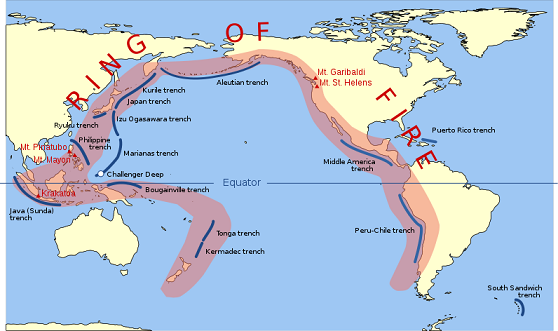The Philippines is in the Pacific Ring of Fire and the two massive earthquakes that occurred in less than two months in other parts of the world should give us ample warning.
Internet search gives this description of the Pacific Ring of Fire: It is an area where large numbers of earthquakes and volcanic eruptions occur in the basin of the Pacific Ocean. It’s an arc stretching from New Zealand, along the eastern edge of Asia, including the Philippines, north across the Aleutian Islands of Alaska, and south along the coast of North and South America. Over 75% of the world’s active and dormant volcanoes are within the arc.
The volatile activities are a direct result of movements of the earth’s plates, which are like giant rafts which often slide next to, collide with, and are forced underneath other plates. There is a tremendous amount of energy created by the movements of these plates. Thus we have volcanic eruptions and earthquakes.
Being spared from it now should not be an excuse to be complacent. Rather we should learn lessons from the experience of Haiti and Chile.
The other day, Chile was hit with intensity 8.8 earthquake. Roads and some buildings were severely damaged and reported deaths reached hundreds.
Last Jan. 12, Haiti was hit by a 7.0 magnitude earthquake . More than 230,000 people died including Filipino peacekeepers.
Scientists quoted by reports said Chile’s Saturday temblor was almost 1,000 times more powerful than the one to hit Port-au-Prince in Haiti. Yet the casualties are over 200,000 less. One report said, “One major factor which will limit the number of deaths in Chile will be its greater level of preparedness. Both the Chilean authorities and the Chilean people are generally well versed in how to cope in such an emergency.”
Chile’s preparedness was borne out of experience. In May 1960, Chile was rocked by a much colossal tremor in the magnitude of 9.5 which killed more than 1,600 people. It was the biggest instrumentally recorded earthquake in the world.
In 1922, central Chile was also rocked with intensity 8.5 earthquake. Studies indicated that Chile was ripe for another major earthquake, thus the preparedness.
Earthquakes are alien to Haitians. No living Haitian had experienced a quake in their country. Survivors and rescuers described abject panic among them— people grabbing cement pillars only to watch them crumble in their hands. They didn’t know about seeking shelter under tables and door frames, and staying away from glass windows.
It pays of course that Chile is wealthy. The Chilean government imposed strict building codes. Chileans have homes and offices built to ride out quakes, their steel skeletons designed to sway with seismic waves rather than resist them. Even low-cost housing structures are earthquake resistant.
Haiti, on the other hand, is very poor. The government is inept and it’s not surprising that there is no building code. Patrick Midy, a leading Haitian architect, is quoted in news reports as saying he knew of only three earthquake-resistant buildings in Haiti.
Cameron Sinclair, executive director of Architecture for Humanity, a 10-year-old nonprofit group that has helped people in 36 countries rebuild after disasters, said the virtue of having earthquake-resistant buildings is shown by after-the-tremor scenes in the two earthquake-hit countries: “When you look at the architecture in Chile you see buildings that have damage, but not the complete pancaking that you’ve got in Haiti,” he said.
Of course, Chile was lucky that the epicenter of last Saturday’s tectonic blast was in a relatively unpopulated area while Haiti’s was right on the edge of the heavily populated Port-au-Prince.
No wonder that the day after the Haiti quake, Sinclair’s San Francisco-based organization received 400 requests for help. As of yesterday, Sinclair said it had yet to receive a single request for help for Chile.
The Chile and Haiti experiences give graphic and valuable lessons for other countries, most especially, the Philippines to learn from. We can choose which model to follow.
Wait, there’s more!: Buy her a gift this Valentines! or send her flowers!
